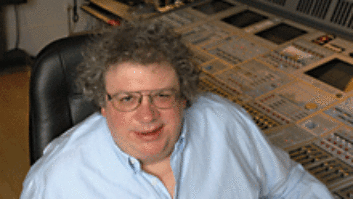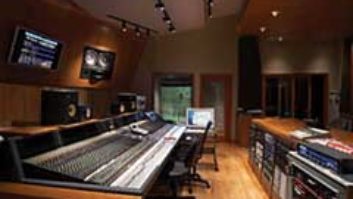In recent years, much of the audio industry’s focus on music’s biggest night—the Grammy Awards show telecast— has been on the broadcast production side as it has made the transition to ATSC transmission and 5.1 surround. This year, the spotlight switched to the audience PA system, which underwent some refinements to its infrastructure.
For this year’s event, ATK Audiotek, longtime production sound provider for the Grammy show, made a major mixing console change, bringing in six DiGiCo desks for front of house and monitors. At FOH, music mixer Ron Reaves handled 168 inputs on an SD7, alongside production mixer Mikael Stewart on a 96-input SD10. At the monitor positions, Tom Pesa and Mike Parker each had a pair of SD10 desks—a main and a backup.
“We’re all sharing the same mic pres, which are under the stage,” explained live system manager/tech Andrew “Fletch” Fletcher. “Tom, the A stage monitor guy, has control of the mic pres for that stage. On the B stage, Mike [Parker] has control of the mic pres. Then for the RF mics, Ron has control, because they go across both stages. And Mike [Stewart] has control of all the production elements.”
The transition to relatively unfamiliar consoles also meant changes to the distribution setup, according to system engineer Jeff Peterson. “We’ve got more layers of backup and failovers than we’ve ever had on this show since I’ve been doing it,” he noted during setup prior to the broadcast.
With each mixer having had only one or two opportunities to use the consoles at previous events, two DiGiCo techs were on hand to provide assistance if required. As Fletch also related, the two FOH desks and each pair of monitor consoles were in mirrored mode for redundancy.
Dual Optocore rings, the topology ensuring dual-path redundancy in the event of a break in the fiber, ensured additional redundancy. The DiGiCo fiber was maxed out at 488 channels, with the Optocore fiber system transporting 160 channels (of a potential 256 maximum).
Noting that this was the third year for the Optocore fiber system, Peterson said, “We’re 100 percent digital from the mic preamp A-to-D conversion to the AES input of the amplifier. That’s the first time we’ve ever been able to do that on the Grammys—a completely digital signal path.”
Looking to the future, with AES/EBU outputs now beginning to be included on some microphone RF receivers, said Peterson, “We could completely eliminate preamps on the microphone signal path.”
The only copper in the system was strictly for backup. “We ran a 16-pair to each mixer location just in case,” he said. In the event of a fiber failure, Peterson could switch the amps to their analog inputs and keep the speaker system running. Should one of the FOH consoles fail, he said, he could switch the Optocore feeds. The remaining console would receive the essential elements that would allow the show to go on.
For the first time, the remote performances from across the street at the Nokia Plaza were also delivered by fiber, which has been installed by AEG, owners of the LA Live complex and the Staples Center, since the Foo Fighters last performed there on the 2008 Grammy show. “There’s fiber all over the LA Live campus,” explained Hank Neuberger, the Grammy telecast sound supervisor. Previously, a separate truck was needed to mix that remote stage performance. But with the addition of the fiber, mic inputs from the plaza simply appeared as Stage C for John Harris and Eric Schilling, who mixed the show’s performances in the Music Mix Mobile truck parked at the Staples Center.
ATK’s JBL VerTec rig was unchanged this year except for the delay speakers. Following the installation of a VerTec rig in the Staples Center in late 2011, ATK was able to eliminate its usual delays and instead used the top eight modules of three installed arrays for the same purpose. That also eliminated an Optocore fiber run to the catwalk for the amps driving the delays. “The only piece of analog audio is what’s feeding the house clusters, because they didn’t have a digital interface that we could get to easily,” said Peterson.
If it were not for the 48 kHz maximum capability of the speaker processors, he further noted, the system could have operated at 96 kHz. In the coming months, he shared, ATK will install optional DSP module into its 300-plus Powersoft amplifiers, which will allow speaker processing to take place within the amps and should permit end-to-end 96 kHz operation at next year’s Grammy show.
“The thing I really like about using optical fiber is that it completely isolates you electrically,” commented Peterson. “Grounding is no longer an issue. With the PA system turned on there is no hum, no noise floor. It’s as quiet as I’ve ever heard it.”





